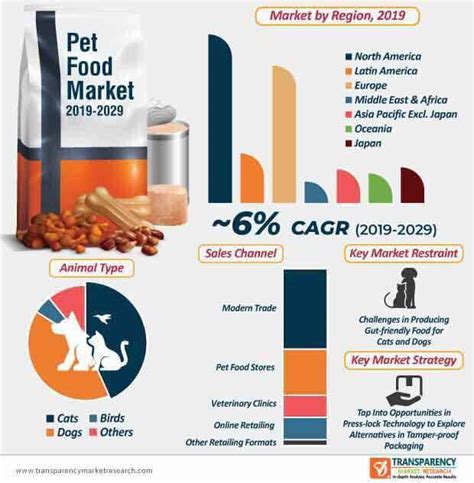Introduction
The global pet food market is projected to be valued at $123.68 billion by 2025, with sustainable options like eco-friendly pet food gaining significant traction. Driven by growing consumer demand for products that are planet-conscious and support their pets’ well-being, the eco-friendly pet food market is anticipated to surge
between 12% and 16% annually over the forecast period.

Key Market Trends
1. Surging Demand for Protein Alternatives
Consumers are increasingly seeking eco-friendly alternatives to traditional meat-based pet food, leading to a rise in the popularity of plant-based and insect-based protein sources.
- A 2021 survey by NielsenIQ found that over 50% of pet owners are interested in plant-based pet food options.
- Insect protein is also gaining traction due to its high nutritional value and sustainable production methods.
2. Sustainable Packaging Solutions
The environmental impact of pet food packaging is a growing concern for consumers. As a result, manufacturers are shifting towards eco-friendly packaging materials such as:
- Biodegradable and compostable materials: Reduce waste and support circular economies.
- Recyclable materials: Minimize environmental pollution caused by plastic waste.
3. Organic and Locally Sourced Ingredients
Consumers are placing a premium on the quality and origin of pet food ingredients, driving demand for organic and locally sourced options.
- A report by the Organic Trade Association revealed that sales of organic pet food in the US grew by over 10% in 2020.
- Locally sourced ingredients reduce the carbon footprint associated with transportation.
4. Transparency and Sustainability Certifications
Consumers are increasingly demanding transparency and accountability from pet food manufacturers. Eco-friendly certifications, such as those offered by the Rainforest Alliance and the Marine Stewardship Council, provide assurance about the sustainability of pet food products.
- A survey by the Pet Food Institute found that over 60% of pet owners consider sustainability when purchasing pet food.
5. Innovative Product Development
Pet food manufacturers are constantly innovating to meet the evolving needs of eco-conscious consumers. Some notable trends include:
- Upcycled ingredients: Utilizing byproducts from other industries to reduce waste.
- Personalized nutrition: Tailoring pet food to individual health needs, minimizing food waste.
Market Dynamics
Market Drivers
- Growing consumer awareness of environmental sustainability
- Demand for healthier and more sustainable pet food options
- Government regulations promoting sustainable practices
Market Barriers
- Higher production costs compared to conventional pet food
- Limited availability of eco-friendly raw materials
- Consumer price sensitivity
Common Mistakes to Avoid
- Relying solely on greenwashing: Making unsubstantiated claims about product sustainability.
- Using unsustainable packaging materials: Undermining the eco-friendly value proposition.
- Overpricing eco-friendly options: Creating a barrier to consumer adoption.
Pros and Cons of Eco-friendly Pet Food
| Pros | Cons |
|---|---|
| Environmentally sustainable | Often more expensive than conventional options |
| Supports ethical and sustainable practices | Limited availability of eco-friendly raw materials |
| Promotes pet health and well-being | May not meet the nutritional needs of all pets |
Case Details: Beyond Meat vs. J.M. Smucker
Two notable examples of companies capitalizing on the eco-friendly pet food trend are Beyond Meat and J.M. Smucker.
- Beyond Meat: Launched “Beyond Meat Jerky,” a plant-based dog treat made with pea protein.
- J.M. Smucker: Acquired Ainsworth Pet Nutrition, a leading producer of organic and sustainable pet food.
Frequently Asked Questions
-
What is the difference between eco-friendly and conventional pet food?
– Eco-friendly pet food uses nachhaltig practices, such as sustainable sourcing and biodegradable packaging. -
Is eco-friendly pet food healthier for pets?
– Eco-friendly pet food is often healthier because it contains natural and organic ingredients. -
Is eco-friendly pet food more expensive than conventional pet food?
– Yes, eco-friendly pet food is often more expensive due to the higher costs of nachhaltig production. -
Where can I find eco-friendly pet food?
– Eco-friendly pet food can be found at specialty pet stores, online retailers, and some traditional grocery stores. -
What are the environmental benefits of eco-friendly pet food?
– Eco-friendly pet food reduces waste, supports sustainable farming practices, and helps protect the planet. -
How can I choose the right eco-friendly pet food for my pet?
– Consider your pet’s individual needs and consult with a veterinarian to determine the best eco-friendly option. -
What are the challenges facing the eco-friendly pet food industry?
– Challenges include the availability of sustainable raw materials, consumer price sensitivity, and the need for industry-wide transparency. -
What is the future of the eco-friendly pet food industry?
– The future of the eco-friendly pet food industry is bright, with growing consumer demand and increasing innovation driving market growth.
Conclusion
The eco-friendly pet food market is poised for significant growth in the coming years. Manufacturers that prioritize sustainability and meet the evolving needs of eco-conscious consumers will be well-positioned to capitalize on this lucrative opportunity. By embracing best practices, overcoming challenges, and investing in innovation, the industry can drive positive change for pets and the planet.





















